The Evolution of Sacred Symbolism: Modern Crucifixes Today
A modern crucifix is a contemporary interpretation of the traditional Christian symbol that features minimalist design, sleek materials, and simplified imagery while maintaining its spiritual significance. If you're looking for information about modern crucifixes, here's what you need to know:
- Design Features: Clean lines, abstract forms, minimalist corpus (figure of Christ), and simplified symbolism
- Popular Materials: Teak, oak, brass, stainless steel, resin, and 14K gold
- Price Range: $20-$300+ depending on materials and craftsmanship
- Size Range: 6 inches (15cm) to 22 inches (56cm) for home display
The modern crucifix represents a significant evolution in religious iconography, blending centuries of tradition with contemporary aesthetic sensibilities. No longer confined to ornate, detailed depictions of suffering, today's crucifixes often feature streamlined designs that focus on resurrection and triumph rather than pain.
This shift reflects broader cultural changes while maintaining deep spiritual meaning. Modern crucifixes have become popular not only in churches but also in homes, where they serve as both devotional objects and design elements that complement contemporary interiors.
What makes these pieces truly distinctive is their ability to honor tradition while speaking to current artistic trends. Many feature the "Christus Triumphans" (Christ Triumphant) portrayal—depicting Jesus with open eyes and dignified posture rather than in agony—a return to early medieval representations that emphasize victory over death.
I'm Mortuary Cooler, an expert in religious iconography who has studied the evolution of modern crucifix designs across different materials and cultural contexts. My experience includes analyzing how contemporary sacred symbols balance traditional meaning with innovative aesthetics to meet the needs of today's faithful.
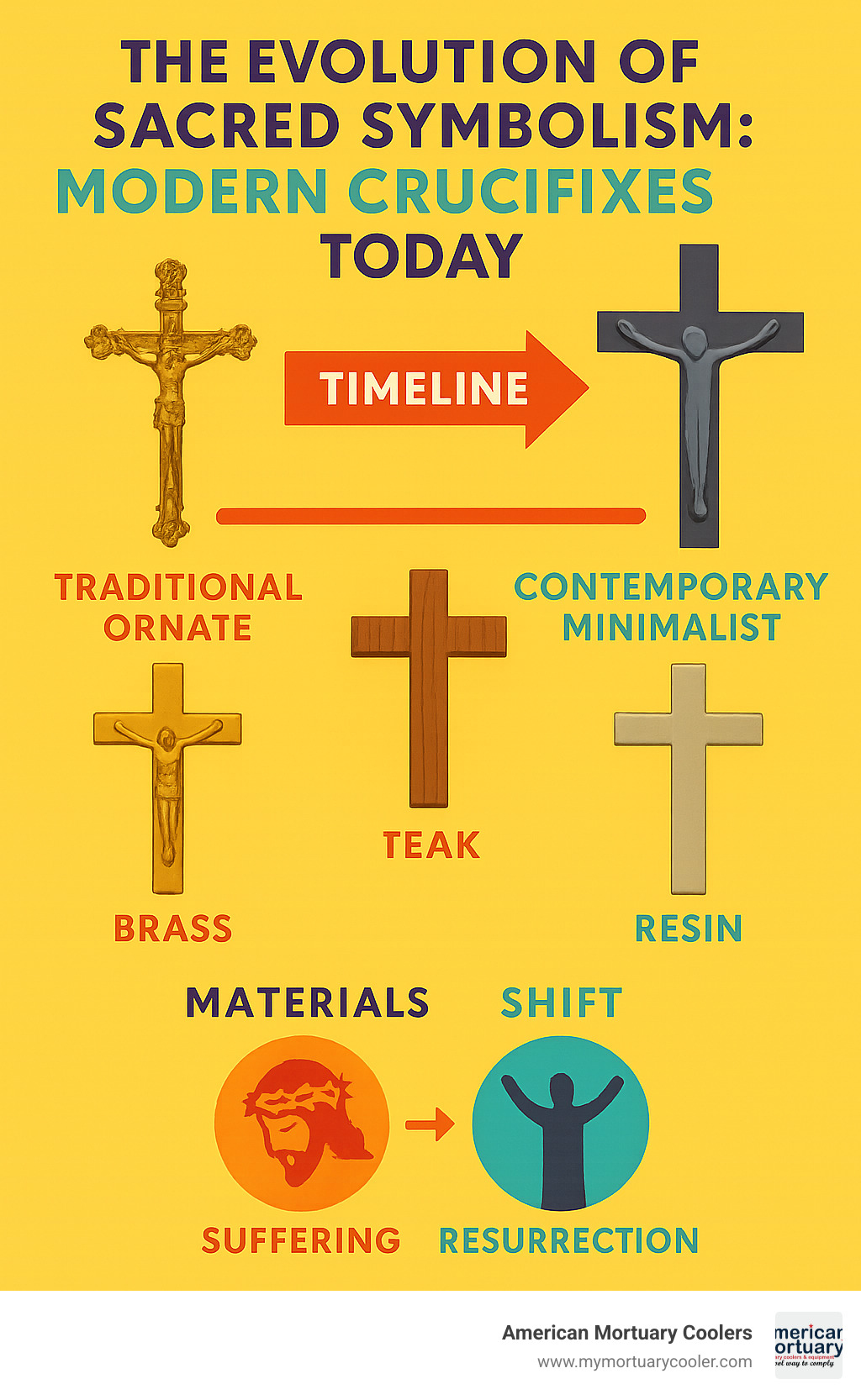
Related content about modern crucifix:
Modern Crucifix 101: Definition, Symbolism & Theology
The modern crucifix is so much more than a pretty wall hanging—it represents a thoughtful theological shift that speaks to today's spiritual sensibilities. While traditional crucifixes often highlight Christ's suffering with detailed wounds and expressions of agony, contemporary designs frequently accept the early Christian concept of "Christus Triumphans" (Christ Triumphant).
"No symbol is more potent or more powerful than a crucifix," as one religious art dealer puts it, and today's designers have found fresh ways to convey this deep meaning. Modern interpretations often feature a corpus (Christ's body) that seems to float with quiet dignity rather than hang in anguish. This subtle shift reflects a greater emphasis on resurrection and eternal life instead of focusing solely on the moment of death.
Even the familiar INRI inscription (Iesus Nazarenus Rex Iudaeorum—Jesus of Nazareth, King of the Jews) gets a contemporary treatment in modern designs. You'll find it simplified, abstracted, or rendered in sleek typefaces that feel current while honoring tradition.
Many of today's crucifixes offer unique perspectives—like the increasingly popular side-view corpus. As one delighted customer shared about their piece: "This 6" contemporary crucifix will stand out in your home with its unique design. Don't be fooled by its small size, though!" These fresh angles give us new ways to contemplate familiar symbolism.
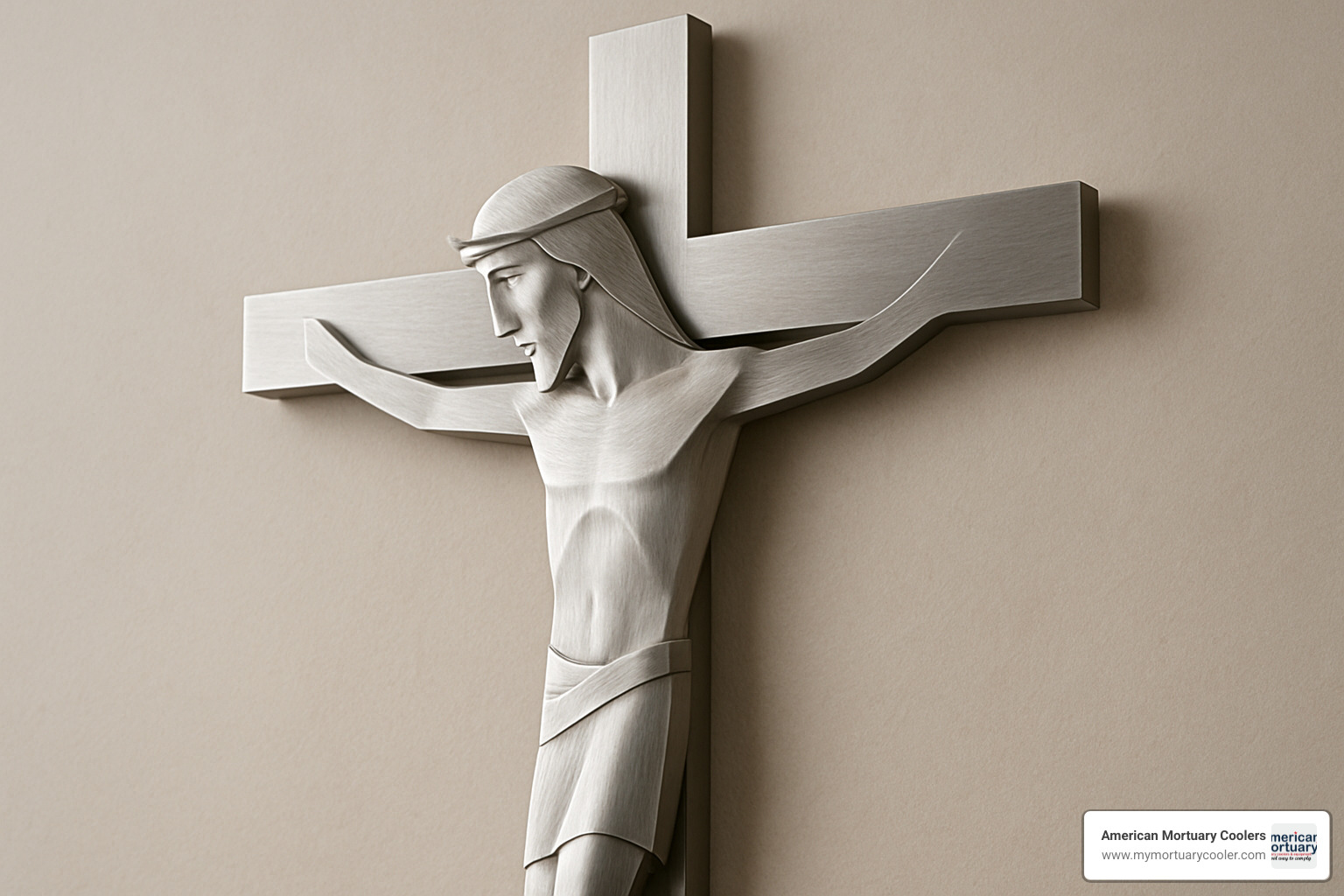
The theological meaning behind these design choices runs deep. Art historian and deacon Henrik von Achen explains one modern installation beautifully: "The crucifix represents anamnesis in the Mass, showing the risen Lord present in Eucharist rather than a historical Golgotha scene." In other words, these pieces aren't just historical artifacts—they're living symbols of ongoing divine presence.
More info about modernist crucifix options
Modern Crucifix vs Traditional Crucifix: Quick Comparison
The journey from traditional to modern crucifix design tells a story about changing artistic tastes and theological emphasis. Here's how they compare:
| Aspect | Traditional Crucifix | Modern Crucifix |
|---|---|---|
| Corpus Depiction | Detailed anatomy, pronounced suffering | Simplified form, dignified posture |
| Materials | Wood, bronze, ivory | Teak, brass, stainless steel, resin, gold |
| Color Palette | Rich, ornate (gold, deep reds) | Muted, minimalist (natural wood, silver tones) |
| Symbolism Focus | Sacrifice, suffering | Resurrection, triumph |
| Design Language | Ornate, elaborate | Clean lines, abstract forms |
| Size/Scale | Often large, imposing | Various sizes, including smaller for home use |
| Theological Emphasis | Atonement through suffering | Victory over death, eternal life |
One retailer lovingly describes their contemporary piece as having "soft, sweeping lines in silver metal" that give even a small 6" crucifix a "modern aesthetic." This shows how today's designs achieve emotional and spiritual impact through neat simplicity rather than elaborate detail.
Don't mistake clean lines for diminished meaning, though. As one cathedral notes about their modern crucifix: "The open-eyed 'Christus Triumphans' posture evokes Christ's victory over death rather than suffering." This actually represents a return to early Christian and Romanesque representations that celebrated resurrection over suffering.
Global Symbols in the Modern Crucifix
Today's modern crucifix designs draw inspiration from a beautiful mix of cultural traditions. Byzantine revival elements appear in pieces featuring frontal, dignified Christ figures with stylized features—often adorned with vibrant azurite blues and gold leaf that connect to Eastern Orthodox traditions while feeling thoroughly contemporary.
Latin American influences bring warmth and vitality to modern designs through organic materials and occasionally incorporating symbolic elements like stylized plants or animals that reference local spiritual practices. These touches create crucifixes that feel both timeless and fresh.
African wood-carving traditions have inspired many designers to accept powerful simplicity—capturing spiritual essence through bold lines and expressive forms. These influences often shine in crucifixes carved from single pieces of wood with minimal decoration but maximum emotional impact.
Some thoughtful modern designs even incorporate subtle interfaith elements, creating bridges between traditions. You might notice geometric patterns reminiscent of Islamic art or proportions that echo Eastern spiritual practices, resulting in pieces that feel universal while remaining distinctly Christian.
One of the most interesting developments is how contemporary crucifixes sometimes reimagine traditional elements in surprising ways. For example, one cathedral crucifix incorporates 223 rosary beads surrounding the cross, including all four sets of Mysteries—a creative way to integrate multiple devotional practices into a single beautiful statement.
Craftsmanship: Materials, Techniques & Sizes
The art of creating a modern crucifix has evolved dramatically in recent years, with craftspeople embracing both traditional wisdom and cutting-edge techniques. Walking through a contemporary sacred art gallery today, you'll notice an impressive variety of materials that would have been unimaginable just decades ago.
Wood remains a beloved foundation, with oak continuing to captivate with its strength and distinctive grain patterns that seem to tell their own stories. Teak has emerged as something of a superstar in the modern crucifix world—its natural oils not only provide exceptional durability but also develop a warm, rich patina over time that many find deeply meaningful. As one artisan-written product description notes: "A stunning sleek take on the classic Catholic staple—The Crucifix" featuring "oak wood + resin" in a minimalistic aesthetic that speaks to contemporary sensibilities.
The metals used in today's crucifixes offer their own unique characteristics. Brass pieces provide a warm golden tone that ages beautifully, developing character with each passing year. I recently came across a remarkable example described as a "Mid-Century Modern brass crucifix with a hand carved teak Jesus sculpture, 1950s Super neat, very puristic and imposing Switzerland." This thoughtful pairing of materials showcases the sophisticated approach many artisans are taking.
Stainless steel has found its place in the modern crucifix landscape, beloved for its clean lines and impressive durability. For more intimate devotional pieces, precious metals continue to shine—some jewelers now offer "14K Yellow Gold Modern Crucifix Pendant" options measuring approximately "23 mm (7/8") long by 16 mm (5/8") wide" and weighing around "1.9 grams," perfect for daily wear.
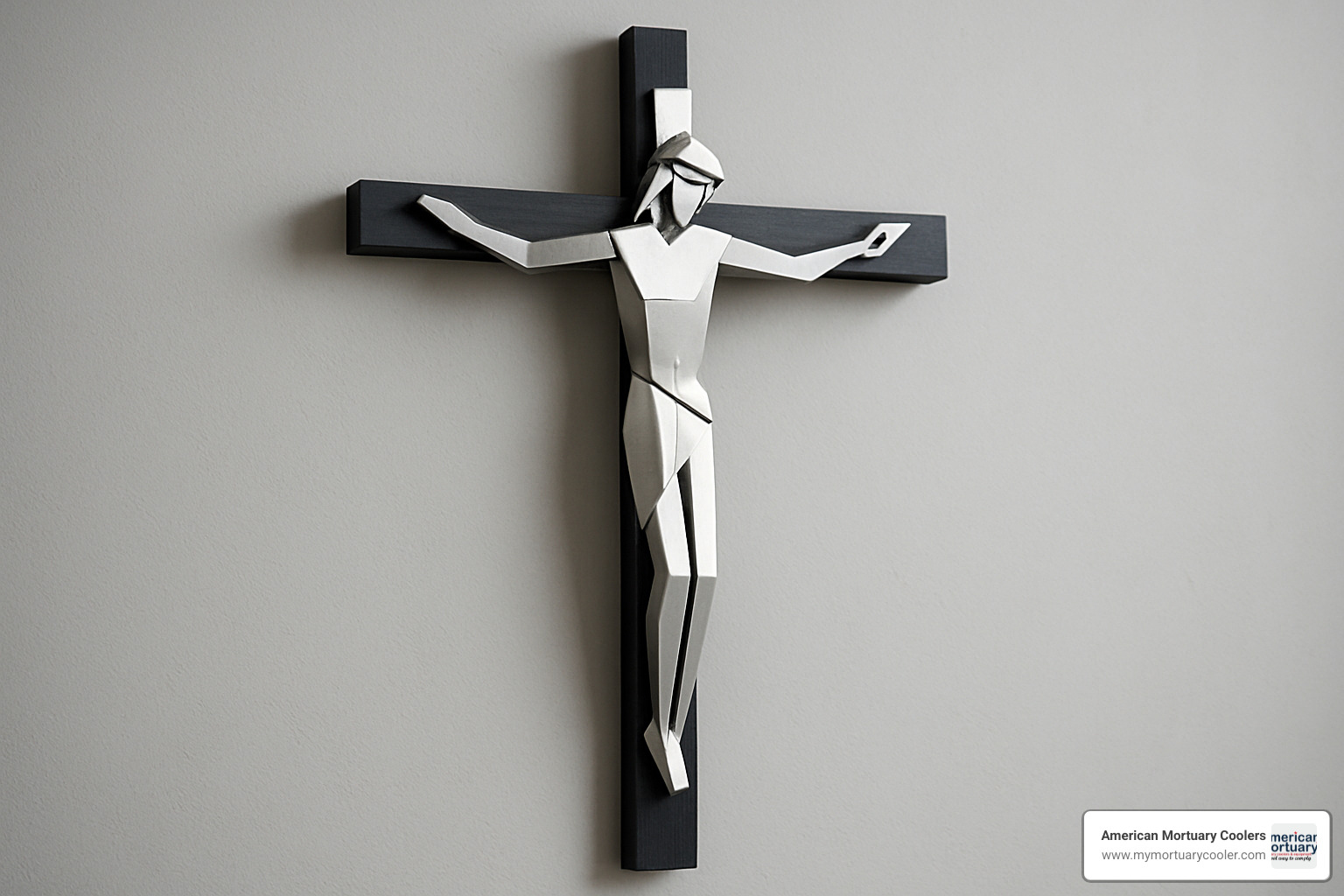
Innovation hasn't stopped with traditional materials. Resin has truly revolutionized what's possible in modern crucifix design. This versatile material allows for translucent effects, embedding other elements, and achieving forms that would be challenging with traditional materials alone. Glass, acrylic, and even thoughtfully repurposed materials have found their way into contemporary pieces that honor both spiritual significance and environmental stewardship.
The techniques used to craft these sacred objects blend timeless traditions with modern innovations. Some artisans still employ egg tempera painting on wooden crucifixes, a method dating back centuries. As one cathedral's documentation reveals: "Use egg tempera for authentic iconographic painting. Employ bright, natural pigments (e.g., azurite) to emphasize spiritual themes."
Meanwhile, technology has expanded what's possible. CNC milling allows for precise, consistent designs that maintain quality across productions. 3D printing has opened new frontiers, enabling complex geometries and customization options that would have been extraordinarily difficult through traditional methods alone.
The size range of modern crucifixes is wonderfully diverse, accommodating various settings and needs. Small devotional pendants (typically 1-2 inches) provide a personal connection throughout the day. Desk or shelf crucifixes (6-8 inches) create meaningful focal points in intimate spaces. Wall-mounted home pieces (8-22 inches) serve as central devotional elements, while larger statement works (several feet tall) transform church environments. One popular contemporary piece measures "11.2" H x 8" W," making it ideal for home display, while another impressive church installation stands "about 7' 3" tall."
| Material | Durability | Maintenance | Approximate Cost Range |
|---|---|---|---|
| Teak | Excellent | Low (occasional oil) | $100-300+ |
| Oak | Very Good | Medium (periodic sealing) | $50-200 |
| Brass | Excellent | Medium (occasional polishing) | $75-250 |
| Stainless Steel | Excellent | Very Low | $40-150 |
| 14K Gold | Good | Low (gentle cleaning) | $300-1000+ |
| Resin/Wood Hybrid | Good | Low | $75-200 |
When selecting a modern crucifix, considering both material and size ensures you'll find a piece that resonates with your space and spiritual needs. The craftsmanship behind these contemporary sacred objects continues to evolve, honoring ancient traditions while embracing the possibilities of today.
Design Trends, Notable Examples & Debates
The world of modern crucifix design is wonderfully diverse, spanning from subtle twists on tradition to bold contemporary statements. Walking through this landscape, you'll find several distinct design movements that have captured hearts and sparked conversations.
Swiss designs from the 1950s continue to cast a long shadow over today's creations. These mid-century pieces strike that perfect balance—"super neat, very puristic and imposing" as collectors often describe them. They feature those clean, uncluttered lines and thoughtful material pairings like warm brass with rich teak that somehow manage to feel both vintage and timeless.
The Scandinavian influence is unmistakable in many of today's most popular modern crucifix designs. With their honest materials, functional beauty, and quiet elegance, these pieces speak in whispers rather than shouts. Light woods, minimal metal accents, and perfectly balanced proportions create a sense of serenity that many find spiritually uplifting. As one retailer lovingly describes their contemporary piece, it offers a "minimalistic aesthetic" that resonates with those seeking both spiritual meaning and design harmony.
Some of the most breathtaking innovations appear in contemporary cathedral settings. Take the Cathedral Crucifix at Holy Rosary Cathedral in Vancouver—a stunning example of traditional iconography executed with a modern sensibility. Their description captures it perfectly: "The open-eyed 'Christus Triumphans' posture evokes Christ's victory over death rather than suffering." Even while using traditional egg tempera, the approach feels fresh and relevant.
For personal devotion, modern crucifix pendants have evolved into sophisticated wearable art. A standout example is the "14K Yellow Gold Modern Crucifix Pendant" that marries timeless symbolism with contemporary proportions. At just "23 mm (7/8") long by 16 mm (5/8") wide," these pieces allow for everyday spiritual expression that complements modern wardrobes beautifully.
The digital frontier has even welcomed the sacred, with virtual crucifixes and NFT (non-fungible token) versions emerging in digital spaces. These pieces pose fascinating questions about how spiritual symbols translate into non-physical fields—can devotion exist in pixels as powerfully as in wood and metal?
Sustainability has also found its way into sacred art, with environmentally conscious crucifix designs using responsibly sourced woods, recycled metals, and eco-friendly production methods. These thoughtful pieces connect our care for creation with spiritual practice in a meaningful way.
Among the most celebrated recent examples is the "oak-resin hybrid" crucifix described as a "stunning sleek take on the classic Catholic staple." This piece has repeatedly sold out, showing just how hungry people are for designs that honor tradition while embracing innovation.
Modern Design Crucifix Pendant in 14K Yellow Gold
The Cathedral Crucifix - Holy Rosary Cathedral Vancouver
Best-Selling Modern Crucifix Styles in 2024
When it comes to what's flying off the shelves in 2024, several modern crucifix styles have captured the public's imagination and devotion.
Those oak-resin hybrids are absolutely everywhere this year. The marriage of natural wood with translucent or colored resin creates a visual conversation between traditional and contemporary that people just can't get enough of. One retailer's "best selling wall crucifix" featuring this construction has "sold out again" multiple times—always a good sign you've hit on something special. The contrast between materials seems to speak to our modern experience of faith: rooted in tradition yet constantly evolving.
Laser-cut stainless steel crucifixes have found their dedicated following too. There's something about the precision of these pieces—intricate patterns and openwork designs rendered with mechanical perfection—that feels both thoroughly modern and deeply reverent. The durability of stainless steel also appeals to practical buyers looking for heirloom-quality pieces that will last generations.
For home decor, wall-mounted minimalist designs with simplified corpus figures have become the go-to choice. As one delighted customer put it: "Everything they make is better than the last – I've never had a more gorgeous modern simple yet detailed crucifix!" Typically ranging from 8-22 inches tall, these pieces make a spiritual statement without overwhelming your living space—perfect for today's more modest homes.
And let's not forget those gift-ready pendants that continue to mark life's most sacred moments. As one jeweler notes, these pieces are "frequently purchased as gifts for sacramental occasions such as Confirmation, RCIA, and Baptism," proving their enduring relevance in contemporary Catholic life. Modern styling makes these pieces appropriate for everyday wear while preserving their deep spiritual significance.
What connects all these popular styles is their skillful balance of reverence and relevance—honoring ancient symbolism while speaking fluently in today's visual language. The most beloved designs achieve that elusive "modern minimalistic aesthetic" without sacrificing the emotional and spiritual power that has made the crucifix such an enduring symbol for centuries.
Controversies Around "Too Minimal" Crosses
The evolution of the modern crucifix hasn't been without its heated discussions around coffee tables and in church halls. Several thoughtful debates have emerged as designers push boundaries.
Perhaps the most fundamental question centers on whether a cross without the corpus (or with a highly abstracted one) still carries the full theological weight of a traditional crucifix. Some traditionalists worry that overly minimalist designs that reduce Christ's body to the barest suggestion might dilute the central message of sacrifice. Others offer a different perspective—that simplified representations can actually heighten spiritual impact by cutting through visual noise to focus on essential meaning.
As one thoughtful theologian points out: "The crucifix represents anamnesis in the Mass, showing the risen Lord present in Eucharist rather than a historical Golgotha scene." This view suggests that modern, simplified crucifixes might actually deepen theological understanding rather than diminish it.
The commercial side of modern crucifix design raises eyebrows too. When crucifixes are marketed primarily as trendy decor items rather than devotional objects, some wonder if we're crossing a line. Marketing language like "Shop now before they sell out again!" can sometimes make these sacred symbols feel more like fashion accessories than aids to prayer—a tension that many find uncomfortable.
Artists and theologians often find themselves in friendly debate over how far abstraction can go while maintaining theological integrity. Some contemporary crucifixes reduce the corpus to highly stylized forms that barely suggest a human figure. While visually striking, religious authorities sometimes question whether these adequately convey the incarnational reality central to Christian faith—the belief that God truly became flesh.
As global influences enrich modern crucifix design, questions of cultural borrowing versus appropriation naturally arise. When designers incorporate elements from Latin American, African, or Asian Christian traditions, there's a fine line between respectful appreciation and decontextualized borrowing, especially when these elements are removed from their cultural homes.
These conversations reflect the healthy tension between tradition and innovation that has always characterized religious art. The most successful modern crucifix designs acknowledge these tensions and engage thoughtfully with tradition while speaking to contemporary hearts and minds. As one cathedral beautifully describes their modern crucifix, it "blends Romanesque iconographic tradition with modern materials and devotional practice to create a living artwork."
How to Choose, Display & Care for a Modern Crucifix (FAQs Included)
Choosing the perfect modern crucifix for your home involves balancing aesthetic appeal with spiritual significance. Whether you're selecting one for yourself or as a meaningful gift, a few thoughtful considerations will help you make the right choice.
When selecting a modern crucifix, think about where it will live. Larger rooms can beautifully showcase more substantial pieces (16-22 inches), while cozier spaces might call for something more modest (6-12 inches). Viewing distance matters too—those beautiful details might get lost if your small crucifix is mounted in a vast room viewed from afar.
The context also guides your choice. Crucifixes intended for church settings need to communicate clearly from a distance, while home crucifixes can be more intimate and personal. As one cathedral notes about their crucifix: "Installed in a cathedral sanctuary to focus the faithful's attention on the Eucharist." Your home setting allows for more personal expression.
When it comes to mounting your modern crucifix, eye level or slightly above tends to work best for most spaces. Many families follow the beautiful tradition of hanging crucifixes above doorways—a practice with deep historical roots that echoes the ancient "titulus" placement. Whatever height you choose, just make sure your mounting hardware can handle both the weight of your crucifix and your specific wall type.
Modern crucifixes make deeply meaningful gifts for life's sacred moments. Many retailers report that these contemporary designs are frequently purchased to commemorate Confirmation, RCIA completion, and Baptism. When selecting a gift, try to balance the recipient's personal style with the significance of the occasion they're celebrating.
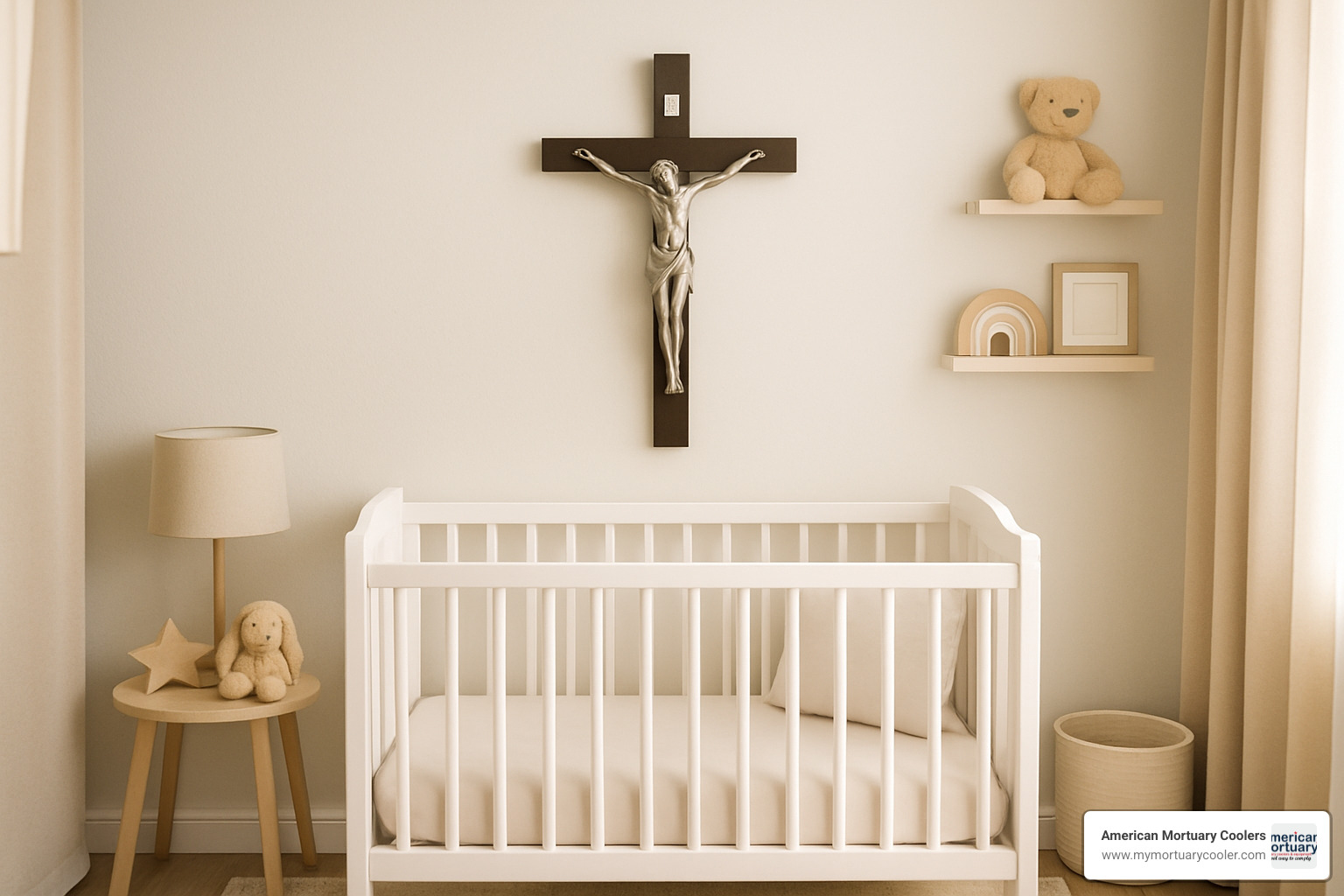
Caring for your modern crucifix depends on its materials. Brass develops a beautiful patina that many collectors prize—you can maintain it with gentle polishing or accept its evolving character. Silver requires periodic attention to prevent tarnishing, while wood benefits from regular dusting and occasional treatment with appropriate wood care products. For contemporary resin pieces, a simple wipe with a soft, damp cloth is usually all that's needed.
Some believers find special meaning in having their crucifixes blessed. Several retailers offer services to have your modern crucifix blessed, with one noting: "At your request we will bring it to receive the Blessing from the Holy Father." This thoughtful touch adds another layer of spiritual significance for many families.
More info about decorative religious items
Where should a modern crucifix hang in my home?
Finding the perfect spot for your modern crucifix can improve both its visual impact and spiritual presence in your home. Many families choose to display their crucifix in central living spaces where family and guests naturally gather. As one homeowner shared: "I searched for 8 months for the perfect crucifix for our living room—a daily reminder of our faith that also complements our modern decor." This central placement makes your crucifix both a focal point for family life and a natural conversation starter.
Bedrooms offer another meaningful location for your modern crucifix. This more private setting creates space for personal prayer and reflection away from the bustle of household activity. Traditional guidance suggests giving "the crucifix its own dedicated, undistracted space in the home," and bedrooms naturally provide this quieter environment.
The doorway tradition remains popular for good reason. Hanging crucifixes above entryways follows historical Christian practice, offering a blessing to all who enter and exit your home. This placement connects your contemporary home to centuries of faith tradition in a beautiful, subtle way.
A growing trend I've noticed is the thoughtful placement of simplified, contemporary crucifixes in children's rooms. One parent mentioned: "I searched 8 months for the perfect crucifix for my son's nursery," highlighting how many families want to introduce these meaningful symbols to children through age-appropriate, modern designs.
Wherever you choose to display your modern crucifix, the key is intentionality—select a spot where it will be seen regularly and can fulfill its dual purpose as both a beautiful object and a meaningful reminder of faith's central truths.
Can modern materials be blessed by the Church?
Absolutely! Your modern crucifix can receive a church blessing regardless of what materials it's made from. Contemporary materials like resin, recycled elements, or non-traditional metals are just as eligible for blessing as traditional wood and metal.
From a theological perspective, blessings confer spiritual significance regardless of the physical composition of the object. One retailer who offers papal blessing services notes: "At your request we will bring it to receive the Blessing from the Holy Father." This service applies equally to crucifixes crafted from traditional materials and those made with more innovative components.
The process is usually straightforward. As one vendor explains: "Fill in the Papal Blessing request field on the cart page before checkout. Proceed to checkout to finalize the blessing request." This simple process bridges traditional practice with contemporary aesthetics.
A customer once shared: "Having our modern oak and resin crucifix blessed gave it even deeper meaning for our family." This experience highlights how the blessing process connects innovative design with timeless tradition.
The Church has always acceptd artistic evolution. Just as stained glass and organ music were once considered "modern" additions to religious expression, today's materials represent a continuation of this adaptive tradition rather than a departure from it. Your contemporary crucifix stands in a long line of artistic innovation in service of faith.
How do I clean a brass or silver modern crucifix?
Keeping your modern crucifix looking beautiful requires some gentle, material-specific care. For brass pieces, start with regular dusting using a soft microfiber cloth to prevent buildup that might be harder to remove later. When deeper cleaning is needed, a solution of mild dish soap and warm water works wonders—just dampen a soft cloth with this mixture and gently wipe the brass surfaces.
After cleaning your brass crucifix, be sure to rinse by wiping with a cloth dampened with clean water, then dry thoroughly with a soft, dry cloth to prevent water spots. Many collectors actually prefer to let brass develop its natural patina over time, which adds character and depth to your piece.
Silver crucifixes require slightly different attention. Regular dusting helps prevent tarnish from developing in the first place. For light tarnish, a silver polishing cloth specifically designed for this purpose works beautifully. More significant tarnish might call for a commercial silver cleaner—just be sure to follow the product instructions carefully, rinse thoroughly, and dry completely afterward.
One collector shared this wisdom: "I've maintained my mid-century brass and teak crucifix for decades with nothing more than regular dusting and occasional gentle cleaning with mild soap and water. Aggressive cleaning strips away character that develops over time." This patience allows your modern crucifix to develop a rich history visible in its patina.
A few important cautions: avoid abrasive cleaners or rough cloths that might scratch delicate metal surfaces. If your crucifix combines materials (like a brass cross with a wooden corpus), clean each component according to its specific needs. And if your piece has particular historical or sentimental value, consulting a professional conservator might be worth the investment.
Conclusion
The journey of the modern crucifix reveals a beautiful balance between timeless tradition and fresh interpretation. Throughout our exploration, we've seen how these sacred objects honor their ancient roots while speaking clearly to contemporary hearts and homes.
What makes today's crucifixes so compelling is their remarkable diversity. From the warm glow of brass-and-teak combinations to innovative resin-wood hybrids that play with light and texture, these pieces demonstrate that sacred art continues to evolve without losing its soul. Each design, whether minimalist or more detailed, serves the same profound purpose – creating a space for contemplation, devotion, and expression of faith.
I've noticed how today's crucifix designs reflect our broader cultural shift toward cleaner aesthetics while often returning to early Christian visual traditions. The resurgence of the "Christus Triumphans" portrayal – showing Christ triumphant rather than suffering – connects modern believers with the earliest Christian communities who emphasized resurrection hope over suffering alone.
When choosing your own modern crucifix, look beyond just how it complements your decor. Consider how it resonates with your personal spiritual journey. Whether it graces your living room wall, hangs above a doorway blessing all who enter, or rests close to your heart as a pendant, these objects invite daily moments of reflection and remembrance.
As one theologian beautifully expressed: "The best way to come to know the cross is to spend some time looking upon it and allowing Our Lord to speak to us through His image." This invitation to quiet contemplation remains the heart of why crucifixes matter, regardless of their design era or artistic style.
At American Mortuary Coolers, we support funeral professionals across Tennessee, Georgia, Illinois, and nationwide with custom solutions for their facilities. While our focus is specialized mortuary equipment, we deeply appreciate the importance of meaningful symbols during life's most significant transitions. The modern crucifix, like other evolving traditions, shows how sacred objects remain relevant by honoring their essential purpose while speaking to contemporary hearts.
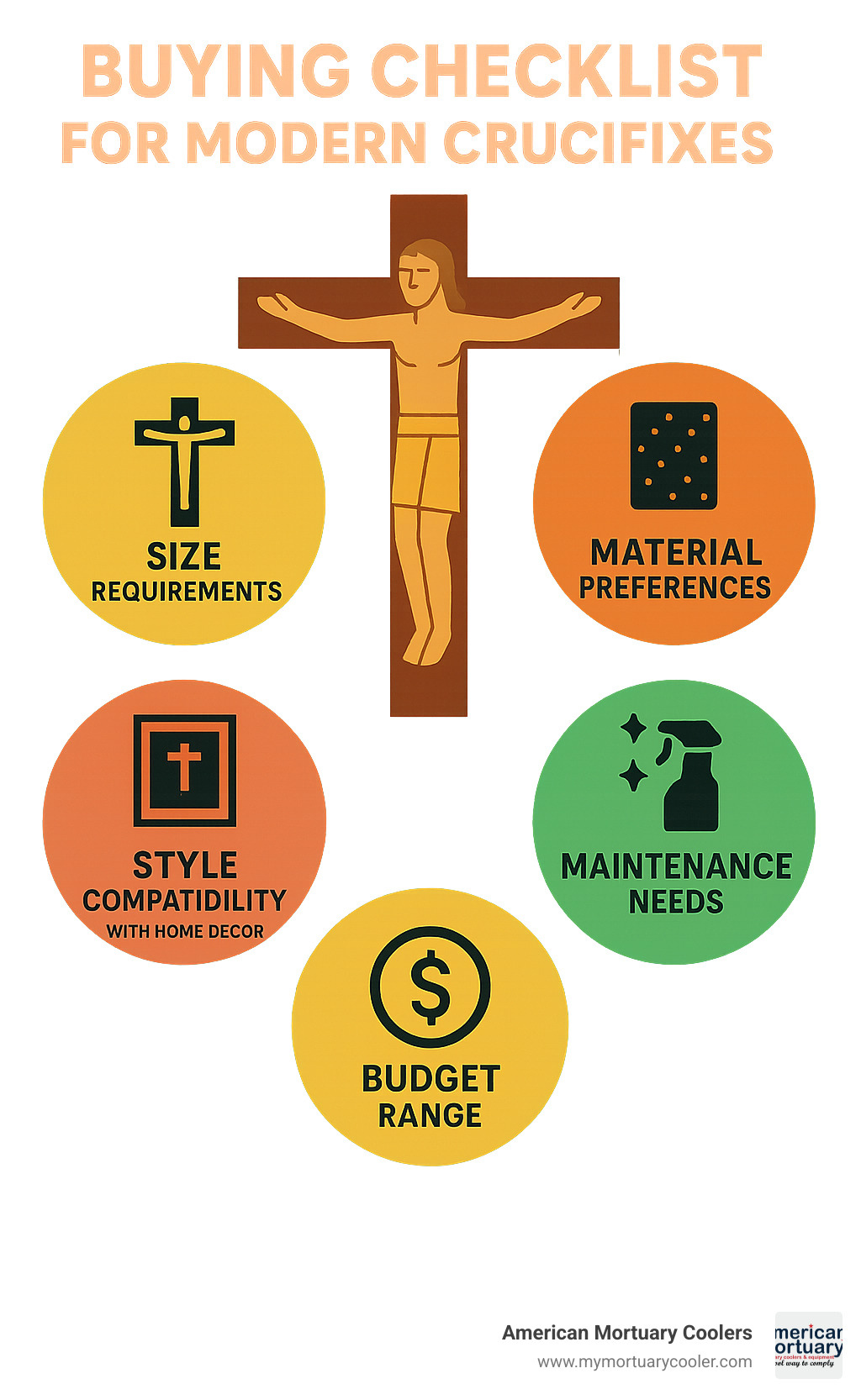
The most meaningful modern crucifix designs achieve something remarkable – they honor tradition while embracing innovation, creating pieces that feel both timeless and fresh. In this delicate balance, they continue Christianity's living visual language that has evolved across centuries while protecting its essential spiritual core.


















